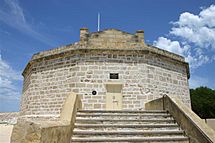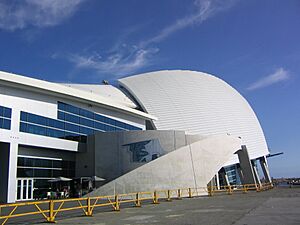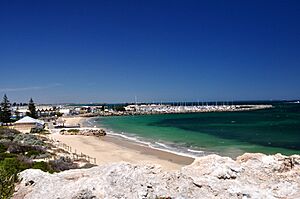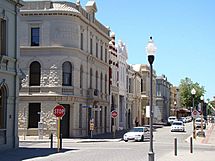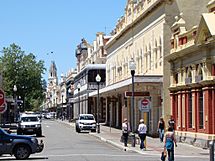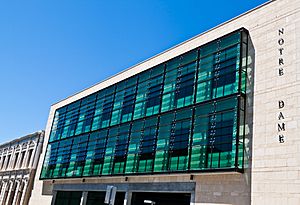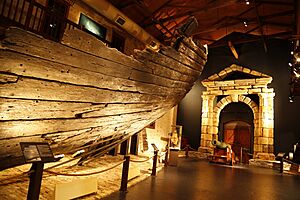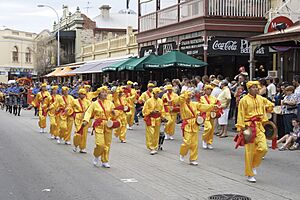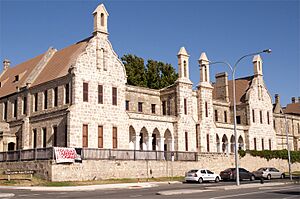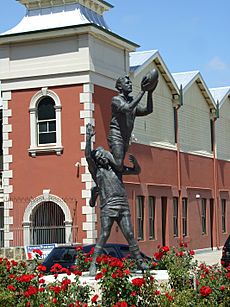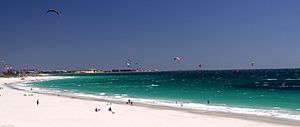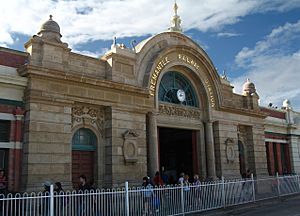Fremantle facts for kids
Quick facts for kids FremantleWestern Australia |
|
|---|---|
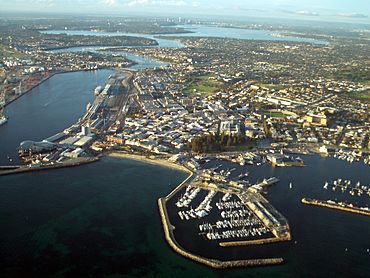
Aerial view of Fremantle
|
|
| Lua error in Module:Location_map at line 416: Malformed coordinates value. | |
| Established |
|
| Postcode(s) | 6160 |
| Time zone | AWST (UTC+8) |
| Location | 19 km (12 mi) SW of Perth CBD |
| LGA(s) | City of Fremantle |
| State electorate(s) | Fremantle |
| Federal Division(s) | Fremantle |
Fremantle (pronounced 'Free-mantle') is a busy port city in Western Australia. It sits right where the Swan River meets the ocean, close to Perth, the state's capital city. Many people call Fremantle by its nickname, Freo.
Long before Europeans arrived, the Noongar people lived here for thousands of years. They called this special place Walyalup, which means "place of the woylie". Dutch explorers visited in the 1600s. Later, in 1829, Fremantle was the first area settled by British colonists in the Swan River Colony. It was named after Captain Charles Fremantle, a British naval officer.
At first, the settlement was quite small. But in 1850, it became Australia's main destination for convicts. The famous Fremantle Prison was built by these convicts. It was used as a prison for a long time and is now a World Heritage Site.
Fremantle became a city in 1929. Its harbour was made deeper for big ships, turning it into a busy trading hub. This was especially important during the Western Australian gold rushes. During World War II, Fremantle was a huge submarine base for Allied forces. After the war, many people from Europe, especially Italy, moved to Fremantle. This helped shape its unique character. The city became even more popular after hosting the 1987 America's Cup sailing race. Today, Fremantle is known for its beautiful old buildings and its lively arts and food scene. It's also the home of the Fremantle Football Club, a well-known Australian Rules football team.
Contents
Discovering Fremantle's Past
First People of Walyalup
The original people of this land are the Whadjuk Noongar people. They called the area Walyalup, meaning "place of the woylie". For the Noongar people, Fremantle was a place for ceremonies and important cultural practices. It was also a big trading spot. For thousands of years, Noongar people gathered here in spring and autumn. They would feast on fish and game.
A special area called Manjaree was located near Arthur Head. This was a major meeting and trading place for different Noongar groups. Even today, Noongar people continue to meet in Walyalup and at Manjaree.
European Arrival and Convict Times
The first Europeans to visit Fremantle were Dutch explorers in 1697. They were led by Willem de Vlamingh. They mapped the area and explored the Swan River. Vlamingh thought it would be a great place for a settlement.
In 1827, Captain James Stirling explored the coast near the Swan River. His good report led the British Government to send Captain Charles Fremantle. On 2 May 1829, Captain Fremantle raised the Union Flag. He officially claimed the west coast of New Holland for Britain. This day is now celebrated as Western Australia Day.
On 2 June 1829, Captain Stirling arrived with the first settlers. They started the Swan River Colony. The settlement of Perth began on 12 August 1829. Captain Fremantle helped Stirling set up the colony. Stirling then decided to name the port settlement "Fremantle" in his honour.
On 1 June 1850, the first convicts arrived in Fremantle. They came on a ship called Scindian. The last convict ship arrived on 10 January 1868. This marked the end of convicts being sent to Australia. The convicts helped build many important buildings in Fremantle.
Gateway to the West

In 1897, a clever engineer named C. Y. O'Connor made Fremantle Harbour much deeper. He removed a limestone bar and sand at the river's entrance. This made Fremantle a great port for large commercial ships. This happened during the big Western Australian gold rushes. Fremantle became a key trading city. It was the gateway for thousands of gold miners heading to places like Coolgardie and Kalgoorlie.
The money from the gold rush led to many new buildings. Pubs, hotels, banks, and warehouses were built. In 1905, the Fremantle tram network opened. In 1919, there was a clash between workers and police at Fremantle Harbour.
Fremantle in World War II
During the Second World War, Fremantle was very important. It became the largest base for Allied submarines in the Southern Hemisphere. Many US, British, and Dutch submarines operated from Fremantle. The port's defences were strengthened, creating the "Fremantle Fortress".
Fremantle was a popular place for submariners during the war. However, sometimes arguments happened between soldiers from different countries.
After World War II
In 1987, Fremantle hosted the 1987 America's Cup yacht race. Australia had won the race in 1983, which was a big deal. Hosting the event greatly helped Fremantle's economy and tourism. A new marina, Challenger Harbour, was built.
In 2012, the City of Fremantle started projects to improve the city. They allowed taller buildings in some areas. In 2013, Fremantle was the first council in Australia to ban lightweight plastic bags.
Fremantle is still the main general seaport for Western Australia. It handles most of the state's container trade.
Fremantle's Location and Weather
Fremantle is built on a series of limestone hills. The Noongar people called these hills Booyeembara. The sandy plains to the east were called Gardoo. The area originally had many Xanthorrhoea and eucalyptus trees. Aboriginal people traditionally used controlled fires to manage this land.
The main part of Fremantle is bordered by the Swan River to the north and the Indian Ocean to the west. The City of Fremantle also includes suburbs like Beaconsfield and North Fremantle.
Fremantle is the end point of the Fremantle railway line from Perth. Major highways like Stirling Highway also connect to Fremantle.
Climate and the Freo Doctor
Fremantle has a Mediterranean climate. This means it has warm, dry summers and mild, wet winters. A special sea breeze, known as the Fremantle Doctor, helps cool the city in summer. It usually arrives between noon and 3pm. Fremantle is often a few degrees cooler than Perth in summer.
| Climate data for Fremantle | |||||||||||||
|---|---|---|---|---|---|---|---|---|---|---|---|---|---|
| Month | Jan | Feb | Mar | Apr | May | Jun | Jul | Aug | Sep | Oct | Nov | Dec | Year |
| Record high °C (°F) | 42.4 (108.3) |
41.0 (105.8) |
39.4 (102.9) |
35.8 (96.4) |
28.3 (82.9) |
26.3 (79.3) |
25.5 (77.9) |
26.0 (78.8) |
26.8 (80.2) |
36.3 (97.3) |
39.0 (102.2) |
40.0 (104.0) |
42.4 (108.3) |
| Mean daily maximum °C (°F) | 27.3 (81.1) |
27.9 (82.2) |
26.4 (79.5) |
23.6 (74.5) |
20.3 (68.5) |
18.1 (64.6) |
17.1 (62.8) |
17.3 (63.1) |
18.5 (65.3) |
20.1 (68.2) |
23.0 (73.4) |
25.4 (77.7) |
22.1 (71.8) |
| Mean daily minimum °C (°F) | 17.8 (64.0) |
18.1 (64.6) |
17.0 (62.6) |
14.9 (58.8) |
12.7 (54.9) |
11.1 (52.0) |
10.0 (50.0) |
10.2 (50.4) |
11.0 (51.8) |
12.3 (54.1) |
14.5 (58.1) |
16.5 (61.7) |
13.8 (56.8) |
| Record low °C (°F) | 11.7 (53.1) |
10.2 (50.4) |
7.4 (45.3) |
5.1 (41.2) |
5.1 (41.2) |
4.0 (39.2) |
3.0 (37.4) |
3.1 (37.6) |
2.2 (36.0) |
5.1 (41.2) |
6.7 (44.1) |
9.4 (48.9) |
2.2 (36.0) |
| Average precipitation mm (inches) | 6.3 (0.25) |
11.3 (0.44) |
16.3 (0.64) |
41.3 (1.63) |
112.8 (4.44) |
165.5 (6.52) |
156.2 (6.15) |
117.7 (4.63) |
69.2 (2.72) |
42.2 (1.66) |
18.2 (0.72) |
11.4 (0.45) |
764.6 (30.10) |
| Average precipitation days (≥ 0.2 mm) | 2.6 | 2.6 | 4.2 | 7.8 | 14.1 | 17.8 | 19.3 | 17.4 | 14.4 | 10.9 | 6.8 | 3.9 | 121.8 |
| Average relative humidity (%) (at 1500) | 57 | 55 | 57 | 59 | 62 | 64 | 66 | 63 | 62 | 62 | 59 | 60 | 61 |
| Source: Bureau of Meteorology | |||||||||||||
Historic Buildings and Places
Fremantle is famous for its old buildings. Many were built by convicts or during the gold rush era. They are often made from local limestone and have fancy designs. The city's "West End" has many beautiful Edwardian buildings.
The Round House is the oldest building still standing in Western Australia. It was built as a jail between 1830 and 1831. It had eight cells and a jailer's home. Whaling used to happen at Bathers Beach below the Round House. A tunnel was built under the Round House for whalers to get to town. The University of Notre Dame Australia has helped restore many buildings in the West End.
When more convicts arrived in 1850, the Round House was too small. So, the convicts built a new, much larger jail called Fremantle Prison. It was finished in the 1850s and used as a prison until 1991. Fremantle Prison was once one of the most well-known prisons in the British Empire. In 2010, it became a UNESCO World Heritage Site. You can visit it today for tours and cultural events.
Other buildings built by convicts include the Fremantle School building and the Commissariat Buildings. The Fremantle Arts Centre was built in the 1860s from local limestone. It used to be a hospital but is now used for art shows and music concerts.
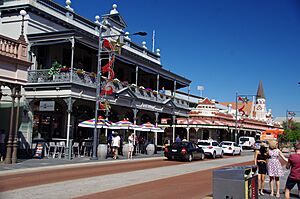
The Fremantle Markets opened in 1897. Here you can find handicrafts, special foods, and fresh produce. The markets also host buskers. The building is from the Victorian era and is a protected heritage site. The Fremantle Markets are next to other historic buildings like the Sail and Anchor Hotel and the Norfolk Hotel.
Some historic buildings in Fremantle have been lost. Others were saved because people fought to protect them. For example, the Oriana Cinema was torn down in 1972. But community groups stopped a bigger road project that would have destroyed more buildings. The National Hotel was badly damaged by fire in 2007. Luckily, its front was saved, and the building has been fully restored.
People and Education
Population and Languages
In 2021, the City of Fremantle had about 31,930 people. Most people (64.9%) were born in Australia. The largest groups born overseas came from England, Italy, and New Zealand. After English, the most common language spoken at home is Italian.
Learning in Fremantle
Fremantle has several places for higher education:
- University of Notre Dame Australia: This university has helped make Fremantle feel like an old European university town. Its campus uses many restored historic buildings.
- South Metropolitan TAFE: This college has several campuses in Fremantle. It offers many courses, from basic certificates to advanced diplomas.
- Curtin University Sustainability Policy Institute (CUSP): This institute focuses on sustainability. It welcomes students studying for PhDs and Masters degrees.
Fremantle also has a major hospital, Fremantle Hospital, which is a teaching hospital.
Schools in Fremantle
Fremantle has several high schools and primary schools:
- John Curtin College of the Arts
- South Fremantle Senior High School
- Christian Brothers' College (CBC)
- Seton Catholic College
- Lance Holt School
- Fremantle Primary School
- Beaconsfield Primary School
- North Fremantle Primary School
- St Patrick's Primary School
Fremantle's Economy

Fremantle has a varied economy with over 2,000 businesses. Most of these are small businesses, with many employing fewer than five people.
The biggest job sector in Fremantle is health care and social assistance. This is because of the important role of Fremantle Hospital. Transport, postal services, and warehousing are also major employers. Retail is another important sector. In 2011, Fremantle's local economy produced $3,677 million.
Media and News
Fremantle has local newspapers like the Fremantle Herald. It also has two radio stations: Radio Fremantle (107.9FM) and 91.3 SportFM. Online, you can find news and reviews about Fremantle on blogs like 'Love Freo' and 'Freo's View'.
Culture and Fun in Fremantle
Fremantle offers many places to eat, with lots of Italian and Asian food, plus fresh seafood. The 'Cappuccino Strip' on South Terrace is famous for its outdoor cafes. The Fishing Boat Harbour is a popular spot for tourists. It has breweries, restaurants, and some of Australia's biggest fish and chip shops. The harbour hosts events like the annual Fremantle Sardine Festival.
Fremantle is also known for its nightlife, with many pubs, bars, and nightclubs.
The city hosts several big festivals each year. The Fremantle Festival is Australia's longest-running community festival. The Fremantle Street Arts Festival brings international street performers to the city. The Fremantle Heritage Festival celebrates local history.
Fremantle has many art galleries and museums. The Western Australian Museum has two branches here. The Shipwreck Galleries show artefacts from old Dutch ships, including the Batavia. The Maritime Museum has exhibits about sea trade and the Indian Ocean. The Army Museum of Western Australia is in an old artillery barracks.
Arts and Music Scene
Fremantle has a large and active arts community. There are many small art galleries and music venues. The Harbour Theatre Inc. has been performing in the city since 1963. J Shed at Bathers' Beach has four artist studios. Old Customs House is home to Artsource, an agency for artists, and has many artist studios.

Fremantle is a hub for music. Many famous musicians grew up here or started their careers here. These include AC/DC frontman Bon Scott, whose grave at Fremantle Cemetery is a popular landmark. A statue of Bon Scott was put up at the Fishing Boat Harbour in 2009. Other musicians with Fremantle connections include John Butler of the John Butler Trio, Little Birdy, The Waifs, and Eskimo Joe. Bands like Tame Impala and San Cisco are also from Fremantle.
Music festivals in Fremantle include the West Coast Blues & Roots Festival. The Fremantle Eisteddfod supports young artists with prizes and concerts.
Fremantle has been a setting for several films and TV shows. The film Windrider (1986) starring Nicole Kidman was shot here. Scenes from Last Train to Freo (2006) and Bran Nue Dae (2010) were also filmed in Fremantle. The children's TV series The Sleepover Club was set and filmed in Fremantle.
Many actors are from Fremantle, including Emma Booth and Ewen Leslie. Sam Worthington and Megan Gale took their first acting classes at John Curtin College of the Arts in Fremantle.
Sports and Outdoor Activities
Fremantle gained global attention when it hosted the America's Cup yacht race in 1987. This event helped to refresh and improve the city. Fremantle has also been a stopover for major round-the-world yacht races. It hosted the 2011 ISAF Sailing World Championships, an important event for the 2012 Summer Olympics.
Australian rules football has been played in Fremantle since the 1880s. The East Fremantle Sharks are very successful, winning many championships. Today, Fremantle is represented in the Australian Football League by the Fremantle Dockers. They play their home games at Perth Stadium. The Dockers also have a women's team that plays at Fremantle Oval.
The Fremantle District Cricket Club plays at Stevens Reserve. Many famous cricketers have come from this club. Three soccer teams from Fremantle play in the Football West State League.
Fremantle has five beaches: Bathers Beach, River Beach, South Beach, Leighton Beach, and Port Beach. The strong afternoon sea breeze, called the Fremantle Doctor, makes these beaches great for wind and kite surfing. The Fremantle Surf Life Saving Club has been active since the 1930s.
You can go fishing from the jetties and along Blackwall Reach on the Swan River. The river is also used for canoeing and rock climbing. There are also islands near Fremantle that are nature reserves. The most famous is Rottnest Island. These islands are great for sunbathing, surfing, and snorkelling.
Getting Around Fremantle
Fremantle is home to Western Australia's largest working port. The Inner Harbour handles most of the state's container trade. The Outer Harbour, south of Fremantle, is a major port for bulk goods like grain.
Fremantle is the end of the electric passenger railway line from the Perth city centre. The Fremantle railway line was one of the first railways in the Perth area, starting in 1881.
Major highways like the Stirling Highway connect Fremantle to Perth.
Passenger ferries travel from the port to Rottnest Island, which is 22 kilometres off the coast. Ferries also go upriver to Perth city centre. Fremantle used to have free Central Area Transit (CAT) bus services to help people get around, but these stopped in October 2023.
Sister and Friendship Cities
Fremantle has special relationships with cities around the world. These "sister city" and "friendship city" links often reflect the different cultures of people who have moved to Fremantle over the years.
Fremantle's sister cities are:
 Seberang Perai, Malaysia (since 1978)
Seberang Perai, Malaysia (since 1978) Yokosuka, Japan (since 1979)
Yokosuka, Japan (since 1979) Capo d'Orlando, Italy (since 1983)
Capo d'Orlando, Italy (since 1983) Molfetta, Italy (since 1984)
Molfetta, Italy (since 1984) Funchal, Portugal (since 1996)
Funchal, Portugal (since 1996)
Fremantle also has friendship-city relationships with:
See also
 In Spanish: Fremantle para niños
In Spanish: Fremantle para niños


